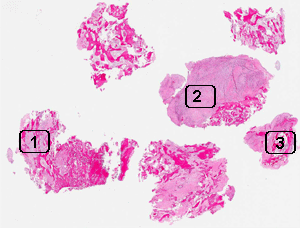|
History: The patient was a 52
year-old woman who was admitted to the emergency room because of back
pain. An osteolytic lesion with compression fracture and compression of
the spinal cord at vertebral level T3 was uncovered on imaging studies.
The lesion was located in the body. As per the patient, she had some
kind of gynecologic malignancy and was treated a few years before the
current incident. A corpectomy with removal of tumor was performed and
yielded the current specimen.
Additional Information:
The original pathology report was obtained later and showed that the
patient had a history of endometrial sarcoma.
Histologic Highlights of this Case:
-
The bone is extensively infiltrated by
large epithelioid cells featured by round to oval cells with a
eccentrically located large nuclei. Many but not all of them have
prominent nucleoli. No real gland formation or mucinproduction are
present. These morphological features are best preserved in areas
with no fibrosis (area 1).
-
In areas with dense fibrosis, the shape
of the cells are distinctly different. They are rather irregular.
The nuclei in these areas do not appear so big and the cells seem to
be compressed by the surrounding fibrosis. (area 2)
-
Some residual normal bone marrow is
present (area 3). Compare these cells with those of area 1 and 2.
Immunohistochemistry:
-
CD10: Positive in practically all tumor
cells.
-
Progesterone receptor: Positive in some
tumor cells.
-
Estrogen receptor: Negative in tumor
cells.
-
Cytokeratin AE1/AE3, cytokeratin 7,
cytokeratin 20, cytokeratin 8/18: Negative in tumor cells.
-
S100: Negative in tumor cells.
-
Vimentin: Positive in practically all
tumor cells.
-
Desmin: Negative in tumor cells.
-
Smooth muscle actin: Negative in tumor
cells.
Comment:
-
Immunohistochemistry: The epithelioid morphology raises the suspicion of a metastatic carcinoma particularly when
there is a know history of gynecologic malignancy. However, these
cells do not have the classic appearance of metastatic carcinoma
cells. On the other hand, this type of epithelioid cells can be seen
in a variety of sarcoma which includes endometrial sarcoma (cytokeratin
negative, CD10 positive). immunohistochemistry for cytokeratins will
be an important step to rule in or rule out metastatic carcinoma in
this case. The immunohistochemistry does not show any
marker that support the idea of metastatic carcinoma. In contrast,
the positive immunoreactivities for CD10 and progesterone are
support of a diagnosis of metastatic endometrial sarcoma. The know
history of endometrial sarcoma is also very helpful.
|
